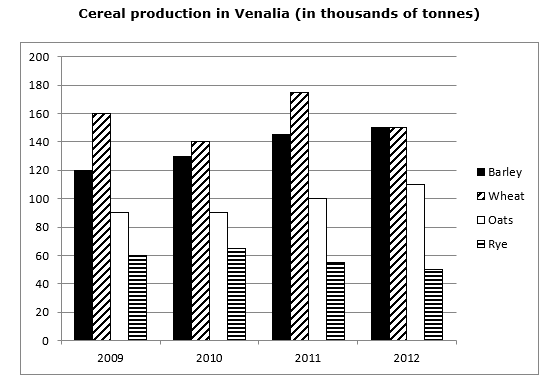
Many candidates think (wrongly) that they’re no good at numerical reasoning. Maybe, at school, they were always “bad at maths”. And just seeing a table of figures is still enough to make them panic.
These candidates should set their minds at rest. People who are good at arts have just as much chance of being successful in the EPSO competition numerical reasoning test as those who are good at sciences. The numerical reasoning test is 20% numerical … and 80% verbal!
In other words, if you’re good at verbal reasoning, you will be good at numerical reasoning. The most difficult thing in numerical reasoning is not the calculations (they’re always elementary and you have calculator you can use). No, the most difficult thing (at least at the start), is understanding the text and interpreting the table or graph correctly. At this stage, even the scientists make mistakes!
Ready? Here is an example question. You will find the answer at the end of this article:

Between 2009 and 2010, wheat production fell by the same proportion in Venalia and Muravia. If wheat production in Muravia was 224 350 tonnes in 2010, by how many tonnes did it fall there between 2009 and 2010?
a) 20 000
b) 28 044
c) 32 050
d) 40 060
e) 84 350
In order to be able to use the information given in the table or graph, candidates must first retranscribe the question in the form of one or more equations. An equation is simply another language. It says exactly the same thing as the question text, but uses different symbols. It is simply a matter of translation. If the translation is correct, you are 80% of the way to solving the question. The rest is calculation. You simply have to know how to add, subtract, multiply and divide.
To be successful in the test, candidates must therefore begin by adopting the “language of equations”. There’s nothing to worry about – the vocabulary and grammar could hardly be simpler. As with all languages, it’s a matter of practice!
Another reassuring point: the numerical reasoning test is the test in which progress is the most evident and fastest. It’s not unusual to see candidates start with 2 or 3 out of 10 and get to 8 or 9 out of 10 after just a few weeks.
Method, training and confidence – these are the keys to success!
Answer: c)
Discover and practise numerical reasoning with our books, our online course and our online tests.




